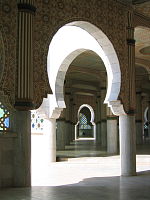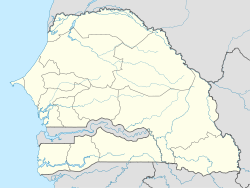
Touba, Senegal
Did you know...
SOS Children, an education charity, organised this selection. Sponsor a child to make a real difference.
| Touba | |
|---|---|
| — Town — | |
| The Great Mosque at Touba | |
|
|
|
| Coordinates: 14°52′N 15°53′W | |
| Country | |
| Region | Diourbel |
| Department | Mbacke |
| Government | |
| • Governor | Shaykh Sidy Mokhtar Mbacké |
| Elevation | 35 m (115 ft) |
| Population (2007) | |
| • Total | 529,176 |
Touba (Arabic Ṭūbā "Felicity") is a city in central Senegal. It is the holy city of Mouridism and the burial place of its founder, Shaikh Aamadu Bàmba Mbàkke. Next to his tomb lies a large mosque, completed in 1963.
History
Shaikh Aamadu Bàmba Mbàkke, commonly known as "Cheikh Amadou Bamba" (1853-1927), is said to have founded Touba under a large tree when, in a moment of transcendence, he experienced a cosmic vision of light. In Arabic, ṭūbā means "felicity" or "bliss" and evokes the sweet pleasures of eternal life in the hereafter. In Islamic tradition, Ṭūbā is also the name of the Tree of Paradise. In Sufism, this symbolic tree represents an aspiration for spiritual perfection and closeness to God.
Aamadu Bàmba founded Touba in 1887. The holy site remained a tiny, isolated place in the wilderness until his death and burial at the site of the Great Mosque, 40 years later. The Great Mosque was finally completed in 1963 and since its inauguration the city has grown at a rapid pace: from under 5,000 inhabitants in 1964, the population was officially estimated at 529,000 in 2007. Along with the neighboring town of Mbacké (founded by Aamadu Bàmba's great-grandfather in 1796), the Mouride conurbation is Senegal's second largest urban area, after the capital region of Dakar.
Mouridism
Touba is the holy city of Mouridism. Aamadu Bàmba Mbàkke, Senegal's most famous Sufi, was more than a spiritual master; he had a social mission as well, that of rescuing society from colonial alienation and returning it to the "Straight Path" of Islam. The city of Touba played a major role in both these endeavors.
Life in Touba is dominated by Muslim practice and Islamic scholarship. A major annual pilgrimage, called the Grand Magal, attracts between one and two million people from all over Senegal and beyond, from as far away as Europe and America. Other, minor pilgrimages occur throughout the year.
For Mourides, Touba is a sacred place. Forbidden in the holy city are all illicit and frivolous pursuits, such as the consumption of alcohol and tobacco, the playing of games, music and dancing. The Mouride order maintains absolute control over its "capital" to the exclusion of usual state-run civil and administrative services. The city constitutes an administratively autonomous zone with special legal status within Senegal. Every aspect of its city’s life and growth is managed by the order independently of the state, including education, health, supply of drinking water, public works, administration of markets, land tenure, and real estate development.
Great Mosque

At the heart of the Mouride holy city lies its Great Mosque, purported to be one of the largest in Africa. Since its completion in 1963 it has been continuously enlarged and embellished. The mosque has five minarets and three large domes and is the place where Amadou Bamba, founder of the Mouride brotherhood, lies buried. The mosque's 87-metre (285 ft) high central minaret, called Lamp Fall, is one of Senegal's most famous monuments. The name Lamp Fall is a reference to Sheikh Ibrahima Fall, one of Bamba's most influential disciples.The mosque is frequently visited by tourists and worshippers alike.
The immediate vicinity of the mosque houses the mausolea of Aamadu Bàmba's sons, the caliphs of the Mouride order. Other important institutions in the centre of the holy city include a library, the Caliph's official audience hall, a sacred "Well of Mercy", and a cemetery. Shaykh Sidy Mokhtar Mbacké is the current leader of the Mourides. He is the seventh Caliph of Mouridism and is the second caliph to not be a son of Ahmadu Bamba Mbacké. Like his predecessors, he resides in a large compound on the main square facing the Mosque.


